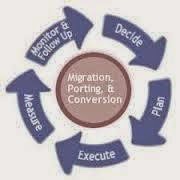Business
analysis has in recent times emerged as a core business practice. Innovative
companies achieve goals through projects that translate customer needs into new
products and services for the customer and business analysts make it happen
more efficiently and effectively. Skilled business analysts act as the vital
link between an enterprise’s IT capabilities and its business objectives
contributing to its profitability, in almost every industry.
The
primary role of business analyst is to implement technology for developing
cost-effective solutions by determining the requirements of a business project,
and communicating them to all stakeholders and partners. He/she is the key role
player in a company’s act of bringing together various pieces of the complex
puzzle called a business process, and act as a binding force between clients,
business users and customers on the one hand and IT developers, QA testers and
the corporate governance on the other.
Common
reasons for failure of solution provided in business analysis:
In
general, solutions often fail to conform to the required norms because of one
of the following conditions or a combination of these:
- Inadequate understanding of the business problem
- Lack of clarity in the stated requirements
- Inadequately explored options to solution
- Mismatch between requirements and project scope
- Inefficient project planning
- Not focusing on value
The
team members are the key drivers of all planned activities in the design,
build, test, and release and operation phases of the IT Service overall
lifecycle. Requirements-driven changes would be recognized and run by the
Business Analyst, and so that the BA’s overall understanding about the ITL
Change Control process is used efficiently in the execution of project.
Following are the practices divided into 2 parts.
Below
are the Best Practices followed by business analyst.
- High Level Scope DocumentHow can you capture project objectives before having a completed set of functional and technical requirements? The main goal of the scope definition document is to clearly describe the limitations of the project .The BA puts together a preliminary High Level Scope document which includes initial document like SOW or any other important document based on the user input and present it to the business users of the organisation.
- Time & Cost EstimationThe development team provide efforts required for building the application based on which business analyst estimates the overall development time and cost and puts it forward to the business users. This would then help in estimating time for user acceptance testing and expert time required for supporting the new solutions.
- Capturing Detailed Business RequirementsOne of the important roles of the business analyst is to capture business requirements using various tools and do detailed analysis of the same. These requirements have to be captured in such a way that they can be easily converted to test cases to support QA testing. A variety of tool sets can be used which can help in merging the QA test results and the original business requirements.
- Requirement Document for Documenting Changes in Business ProcessesMost organizations have a group of business process analysts (BPA) specializing in documenting current state and the desired end state of business processes, through a flow chart tool.
- Requirements Document for Development of User TrainingIt is the job of business analyst to document the training requirements which describes the basic and timing requirements and a high level description of the performance objectives that need to be achieved through training of the operational or support users for the product under development.
Business
strategy and IT Services are indirectly related to each other. IT Services are
built to substantiate business processes which are an integral function
fulfilling the business requirements, which are defined by business strategy. Thus,
the role of the Business Analyst is crucial to define and deliver the right IT
Services.
About Author:
Nisha Bhatt is a consultant in Systems Plus Pvt. Ltd. Within Systems Plus, she actively contributes to the areas of Technology and Information Security. She can be contacted at: nisha.bhatt@spluspl.com









